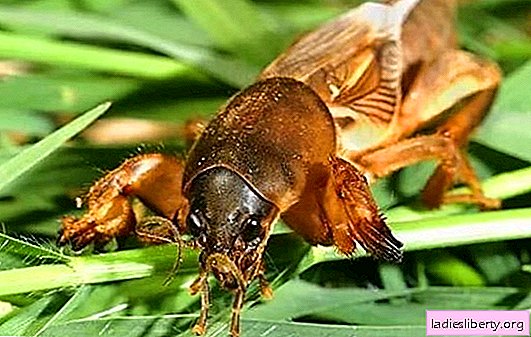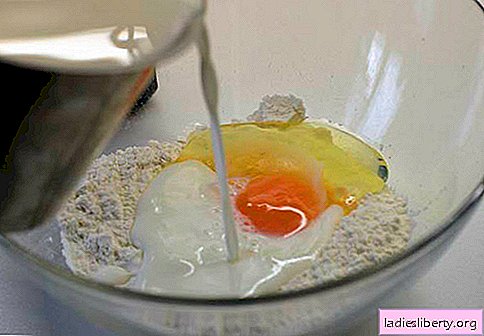
Bears are frequent inhabitants of our gardens, they dig land in the beds, spoil the seedlings and often destroy the root crop. But these insects for some gardeners remain "strangers."
Bear: description
This pest grows up to 5 cm in length, although sometimes gardeners say that they came across insects up to 15 cm. The bear’s chest is protected by durable chitin, under which it can hide even part of the head. Her eyes are large, strong jaws on her head, antennae-whiskers grow. The forelimbs have claws, it is convenient to dig moves in the soil. The insect has wings, but warm air is necessary for their work, for this reason the bear can fly up rarely, the pest swims well. At night, especially during the mating season, the insect begins to chirp, tweet and make loud trills with the help of the friction of the wings against each other.

Bears build their nest shallow with dimensions of 6x6 cm, where the insect lays up to 500 eggs, of which larvae appear after 14-15 days. Their body shape is similar to an adult insect, only differs in gray. The insect mainly lives underground, appearing on the surface of the earth only at night, the bear spends the winter at a depth of more than 2 meters or hide in compost heaps. The insect eats not only root crops, it also uses earthworms for food.
Fighting the Bear
You can find out that the bear settled on the site, you can see on the raised ground in the beds, on the rolled lumps of soil, which are clearly visible after the rain. The pest is most active in May, at which time they begin to crawl out of already warm soil. At this time, you need to make shallow pits in the ground and fill them with fresh manure mixed with chopped straw. Bears gather in egg-laying pits to create favorable conditions for their larvae. After a month, everything that is in the traps, including the larvae, is taken out and burned.

To surely exterminate this insect, you need to find their nests. In the summer they are in the soil at a shallow depth, they are found even when digging. The excavated nests are gently pulled out with a lump of earth, put into a container and destroyed. It is advisable to do this without letting the female escape. If she was able to escape, then lay out the poison granules in all the discovered moves.
There is another way to destroy the pest, after you find the nest, you need to fill it with soapy water so that it can get into all the dug passages. Soap solution - 10 g of laundry soap is diluted in 10 liters of water, 50 g of washing powder is added to the solution. You can fill the passages with vegetable oil and water - mix 1 tbsp. l Oils with 4 liters of water.
If you could detect the pest at the end of the season, then wait until autumn, when the soil temperature drops to 8 degrees (but not lower), prepare hunting pits, 50-60 cm deep, cover their walls and bottom with plastic wrap, fill in the manure that started to burn and cover everything with some kind of lid. After the frost sets in, remove the dung in which the bears gathered from the pits and scatter it in the beds. Insects will die from low temperature, already at 5 degrees heat they practically stop moving.
How to deal with the bear in folk ways
There are many effective folk recipes for fighting this insect; they scare it away or destroy it without harming mammals and beneficial insects. For example, if after a week several times watering the beds with infusion of onion husks, the bear will be removed from your territory. To prepare this product, you need to pour a kilogram of scraps and husks of onions in a bucket of water, it is necessary to insist for 4-6 days, then the infusion must be filtered and diluted with water in a ratio of 1: 5.
You can use traps for catching the bear, in which honey or beer is used as bait. Dig a glass jar into the ground, smearing its neck with honey, cover with a piece of thin metal on top and fill the hole with straw. You can dig a can into the ground by pouring half a glass of beer into it, and cover it with thin metal or thick cardboard on top, and after 15 days, get traps with the caught insects.

You can get rid of the misfortune with the help of dried and finely chopped eggshells, mix it with sunflower oil and pour a tablespoon of all the grooves or holes when sowing seeds or planting seedlings. The bear will begin to feast on this fragrant mixture, which will certainly destroy it.
How to get rid of the bear in the garden forever
Pesticides from the bear are used, if other methods could not help, here are a few effective compounds that destroy the pest:
• Medvetox - granules, with a taste that is pleasant to the pest and fatal, the bear must only eat 1 granule for death;
• Bearberry - an effective drug in the form of a solution, does not harm the environment;
• Chops - a safe and effective tool, produced in the form of bright granules that fall asleep in passages dug by a bear;
• Thunder is an effective composition, but it contains carcinogens, for this reason it must be used carefully, granules are poured into the pest moves 3-4 pieces.
Prevention
It’s much easier to prevent the bear from entering the site than to destroy it. A bear will not start in your garden if, during the autumn period, dig up beds on the bayonet of a shovel - an adult pest and its larvae will die from low temperature. The bear often falls on the beds with manure, which fertilize the soil, instead of it you can fertilize the beds with chicken droppings. Bears breed quickly in warm soil, and to reduce the temperature of the soil, mulch the beds with sawdust or straw.
These insects do not like the smell of chrysanthemums, calendula, marigold, parsley, coriander, cilantro and garlic, they can be planted in the aisles. Medvedka avoids fresh needles and alder foliage, they are buried in small trenches dug around the beds. They say that they are scared away by naphthalene, sprinkled along the perimeter of the beds in pre-prepared furrows.
In a greenhouse, a pest is repelled by mixing kerosene with sand in a ratio of kerosene of 50-70 ml per 1 kg of sand, this amount is used per 1 m² of beds. Kerosene is poured into the sand and everything is well mixed, then several shovels of dry soil are added and mixed again. When planting seedlings, this mixture is distributed on the surface and mixed with the ground.
You can protect the plantings from the pest by treating the roots of the seedlings with Prestige or Actart preparations. And anyone who is not afraid of the smell of rotten fish can use this technology - transplanting seedlings, they drop a small fish in each hole. When it deteriorates, the smell will scare away the pest, and the bear will leave your beds.
Plants with compact roots can be saved by planting a seedling in a plastic bottle. Such "armor" will not allow the insect to get to the plant.
It is good to attract biological enemies of the pest - these are insectivorous animals and birds. If they live on your site, you will not be able to find out what the bear looks like.











